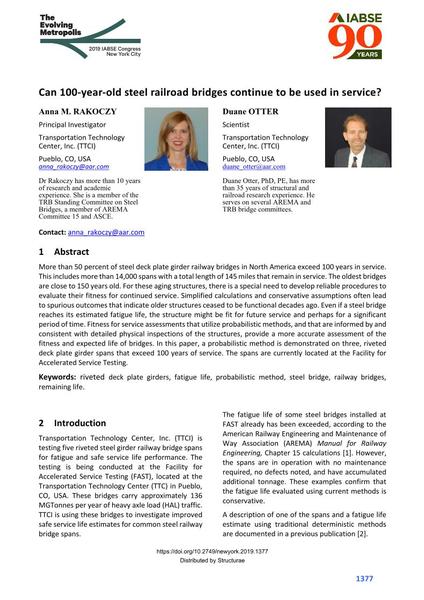Can 100-year-old steel railroad bridges continue to be used in service?

|
|
|||||||||||
Bibliografische Angaben
| Autor(en): |
Anna M. Rakoczy
(Transportation Technology Center, Inc. (TTCI))
Duane Otter (Transportation Technology Center, Inc. (TTCI)) |
||||
|---|---|---|---|---|---|
| Medium: | Tagungsbeitrag | ||||
| Sprache(n): | Englisch | ||||
| Tagung: | IABSE Congress: The Evolving Metropolis, New York, NY, USA, 4-6 September 2019 | ||||
| Veröffentlicht in: | The Evolving Metropolis | ||||
|
|||||
| Seite(n): | 1377-1381 | ||||
| Anzahl der Seiten (im PDF): | 5 | ||||
| DOI: | 10.2749/newyork.2019.1377 | ||||
| Abstrakt: |
More than 50 percent of steel deck plate girder railway bridges in North America exceed 100 years in service. This includes more than 14,000 spans with a total length of 145 miles that remain in service. The oldest bridges are close to 150 years old. For these aging structures, there is a special need to develop reliable procedures to evaluate their fitness for continued service. Simplified calculations and conservative assumptions often lead to spurious outcomes that indicate older structures ceased to be functional decades ago. Even if a steel bridge reaches its estimated fatigue life, the structure might be fit for future service and perhaps for a significant period of time. Fitness for service assessments that utilize probabilistic methods, and that are informed by and consistent with detailed physical inspections of the structures, provide a more accurate assessment of the fitness and expected life of bridges. In this paper, a probabilistic method is demonstrated on three, riveted deck plate girder spans that exceed 100 years of service. The spans are currently located at the Facility for Accelerated Service Testing. |
||||
| Stichwörter: |
Eisenbahnbrücken Stahlbrücke
|
||||
